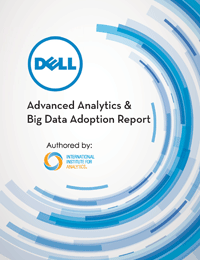Recently, I read an article in a leading business magazine in which the author—a marketing leader—commented on the use of his marketing budget. He wrote about how the fragmentation of media had spread his budget across events, television, print and digital channels. In such a situation it was difficult for him to get a good idea of the effectiveness of his investments. He was looking for deeper insight that would help his decision-making.
Thanks to advanced analytics, there may be some solutions to his situation.
At Dell, our Digital Business Services team has seen many organizations take the initial steps for deploying analytics to gain insight into the workings of their own value chains. Whether it is marketing or finance, across the board business functions are increasingly leading the charge, and in that process creating a new paradigm for business transformation. But the increasing complexity of decision-making is also leading organizations to look at advanced analytics to provide deeper insight, and help them meet their business objectives. Last year, Dell Services commissioned the International Institute of Analytics to author a survey-based report. The Advanced Analytics and Big Data Adoption Report is based on responses from more than 300 business and technology leaders in the U.S. who make decisions based on analytics.
 One key finding is that almost 70 percent of the respondents reported their organizations were using, or planning to use, analytics in decision-making. While finding is along expected lines, the surprising finding was that only five percent of early adopters feel they have reached the highest level of maturity. In my opinion, this gives us an idea how much progress we still have to make in deploying advanced analytics. In other words, we’ve only scratched the surface. And that’s a very exciting proposition for 2015!
One key finding is that almost 70 percent of the respondents reported their organizations were using, or planning to use, analytics in decision-making. While finding is along expected lines, the surprising finding was that only five percent of early adopters feel they have reached the highest level of maturity. In my opinion, this gives us an idea how much progress we still have to make in deploying advanced analytics. In other words, we’ve only scratched the surface. And that’s a very exciting proposition for 2015!
Another related finding reported the maturity level of the analytics program of an organization was directly related to the involvement of senior management. Organizations in which senior executives were involved in analytics decisions had more mature programs, and sound investments and direction. In my opinion, 2015 is the year more senior executives will get involved in developing the analytics programs for their businesses.
Traditional senior technology executives, such as CIOs and CTOs, will be directly involved in analytics programs. Interestingly almost 29 percent of organizations have Chief Analytics Officers involved in strategic decisions—especially those with a higher degree of maturity. As a result, with advanced analytics, organizations can continue to invest in areas that will give them a competitive edge.
Knowing which marketing channel is effective is a big differentiator, and advanced analytics just might help marketing leaders gain that competitive edge. Survey respondents indicated they are using advanced analytics for various tasks, including financial performance, customer recruitment, retention, loyalty programs, and product usage habits. This clearly shows that organizations believe advanced analytics offers significant business benefits and continued investments can help advance business maturity levels.
Dell has recently filed a patent which will help marketing organizations effectively allocate marketing budgets across online marketing channels. This could go a long way toward solving marketing mix problems.
If you are interested in what advanced analytics can do for your business, check out Dell’s Digital Business Services offerings, or contact a Dell Digital Business Services representative. And watch this blog, follow Dell Services on Twitter or LinkedIn for more news on how advanced analytics are helping businesses gain a competitive edge.
